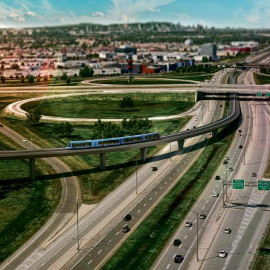 Québec’s largest construction project in 50 years is being rushed through a superficial consultation process to the detriment of users, non-users, and the climate. Despite attractive alternatives, the outcome, earnest participants are beginning to understand, is pre-ordained.
Québec’s largest construction project in 50 years is being rushed through a superficial consultation process to the detriment of users, non-users, and the climate. Despite attractive alternatives, the outcome, earnest participants are beginning to understand, is pre-ordained.
Alain Dubuc’s piece in Wednesday’s La Presse entitled “REM : au pays des chialeux” provides a surprisingly thin environmental and social analysis, especially considering his candid coverage of the contentious federal carbon tax announcement a few days prior. Nonetheless, the Montréal Climate Coalition accepts with gratitude his distinction of Bronze medalist in the push for a rational, calm, and transparent conversation about this important societal choice.
It’s no wonder Dubuc and others are enamored by the proposal. CDPQ Infra’s PR machine has done brilliant work selling this project’s environmental credentials to the public (Electric? What more could you ask for!), but the fact remains that they refuse outright to analyze GHG emissions stemming from the project’s full life cycle. In a context of supposed carbon austerity, such a position is morally and environmentally untenable.
Three years ago, the MTQ faced a similar decision with the Turcot interchange. In hailing it as a ‘carbon neutral’ project, they conveniently omitted the two most significant impacts on GHG emissions: the production of millions of cubic meters of cement and other materials, and the solo-driving suburban sprawl that it would continue to facilitate.
Despite the lack of a comprehensive evaluation of GHG emissions, environmental groups have struggled to publicly oppose the project after having applauded so enthusiastically upon its announcement. Unfortunately, the difference between appearance (CDPQ Infra’s polished images and videos) and reality (massive parking lots and a slew of 60s-style concrete viaducs snaking through the city) is not insignificant.
It’s hardly surprising for CDPQ Infra to gloss over emissions accounting, since from their perspective, only one criteria is of ultimate concern: the bottom dollar. This project was conceived with ROI in mind, while concerns regarding integration with existing networks, service to dense communities and low-income neighbourhoods, and attention to environmental consequences were clearly subordinate. Examine the density and affluence (see map below) of the neighbourhoods surrounding the proposed 12 new stations and draw your own conclusions.
As one of the project’s most outspoken proponents, Mayor Coderre presumably finds the refusal to conduct a comprehensive GHG assessment inconsequential. That’s not surprising either, given that Montréal’s current administration refuses to measure the city’s collective emissions on a regular basis. The last city-wide GHG inventory was conducted in 2009 and exposed a cavernous gap between performance and objectives. The meagre funds necessary to conduct another inventory have yet to be mustered.
The clock is ticking. The last 16 months have set successive records for global average temperatures. By conservative estimates, we will reach the 1.5°C threshold of warming in roughly 15 years.
We stand at the eleventh hour, with record global temperatures being set for the past 16 straight months, a mere 15 years away from surpassing the 1.5°C temperature threshold, and many climate scientists are at a loss as to how they can better convey the gravity of the data they are observing. It is projects like the Réseau Électrique Métropolitain that have them in disbelief. In an era where greenhouse gas reductions should be a primary decision criteria in every major investment – especially those involving public funds – such an analysis is effectively non-existent.
The Coalition Climat Montréal, comprised of 36 segments of the population who have rallied behind a vision of a carbon neutral Montréal by our 400th anniversary, opposes CDPQ Infra’s Réseau Électrique Métropolitain as it does any project that fails to comprehensively assess climate impacts of its full life cycle. Ignorance is no longer an excuse, but a pretext for wilful blindness and calous disrespect when faced with the evidence that has taken thousands of researchers decades to mount.
